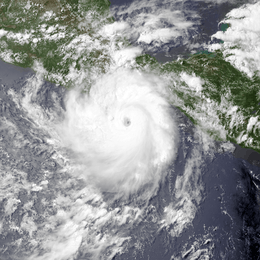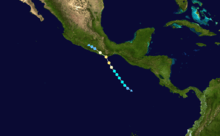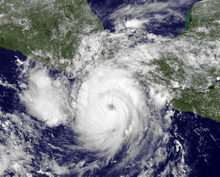Hurricane Carlotta (2012)
| Category 2 hurricane (SSHWS/NWS) | |
 Hurricane Carlotta at peak intensity as a Category 2 hurricane, nearing landfall. | |
| Formed | June 14, 2012 |
|---|---|
| Dissipated | June 17, 2012[1] |
| (Remnant low after June 16) | |
| Highest winds |
1-minute sustained: 110 mph (175 km/h) |
| Lowest pressure | 973 mbar (hPa); 28.73 inHg |
| Fatalities | 3 direct, 4 indirect |
| Damage | $12.4 million (2012 USD) |
| Areas affected | Southwestern Mexico |
| Part of the 2012 Pacific hurricane season | |
Hurricane Carlotta was the easternmost tropical cyclone in the Eastern Pacific to make landfall at hurricane intensity since 1966. The third tropical cyclone and third named storm of the 2012 Pacific hurricane season, Carlotta developed slowly into a tropical depression from a tropical wave southwest of Central America on June 14. It moved generally west-northwestward and by the following day, strengthened into tropical storm strength. Thereafter, gradual intensification occurred and the storm reached hurricane strength on June 15. Rapid intensification ensued further, as Carlotta peaked as a 110 mph (175 km/h) Category 2 hurricane on the same day on June 15. At 0100 UTC the following day, Carlotta made landfall near Puerto Escondido, becoming the easternmost landfalling Pacific hurricane in recorded history.[2] The next day the storm began to weaken as it moved onshore Southwestern Mexico. Carlotta continued to weaken rapidly, eventually dissipating on June 16.
Throughout Mexico, widespread power outages and wind damage was reported, particularly in Oaxaca. Infrastructural damage was also reported due to winds and rain, as well as damage to crops. Rainfall from Carlotta peaked at 13.78 in (35.0 cm) in San Juan Bautista Tuxtepec. Numerous mudslides resulted from the heavy rains, which blocked roads and damaged structures. At least 29,000 homes and 2,500 businesses sustained damage from Carlotta, mostly in Oaxaca. Seven people were killed by Carlotta, and the state of Oaxaca requested MX$1.4 billion (US$107.7 million) for repairs to public infrastructure.[nb 1]
Meteorological history

On June 12, a tropical disturbance developed off the west coast of Costa Rica, moved westward and entered the eastern Pacific after crossing Panama.[2][3] The system became better organized as it tracked to the west-northwest as a westerly Kelvin wave provided favorable conditions for development.[2][4] Convection increased around a developing low pressure area, and the National Hurricane Center (NHC) estimated a 50% chance of tropical cyclogenesis by late on June 12.[5] After further organization, the NHC initiated advisories on Tropical Depression Three-E at 0300 UTC on June 14, while the system was located about 515 mi (830 km) south-southeast of Puerto Ángel, Oaxaca. At the time, the depression was located in an area of low wind shear and warm sea surface temperature conditions that were considered favorable for intensification. In addition, it had a small circulation, which increased the possibility for rapid deepening. The system moved northwestward after forming due to an extended ridge to the northeast.[6] About six hours after forming, the depression intensified into Tropical Storm Carlotta, after rainbands increased around the center.[7]
With continued favorable conditions, Carlotta quickly developed a ragged central dense overcast, or centralized area of convection.[8] An eye feature began developing on June 15,[9] and later that day Carlotta intensified into a hurricane while approaching southeastern Mexico.[10] A Hurricane Hunters flight late on June 15 indicated Carlotta was rapidly intensifying, observing winds of 110 mph (175 km/h) in the eye and well-established outflow; the crew also observed flight-level winds of 114 mph (183 km/h). The NHC initially predicted the hurricane would move along the Mexican coast just offshore, which would have allowed Carlotta to maintain much of its intensity.[11] Shortly after its peak, Hurricane Carlotta weakened slightly as to the eye's began to interact with land.[12] The hurricane made landfall near Puerto Escondido, Oaxaca early on June 16, with winds estimated at 105 mph (165 km/h) and a minimum pressure of 976 mbar (28.8 inHg) shortly after 0100 UTC on June 16[13] becoming the easternmost tropical cyclone in the Eastern Pacific to make landfall at hurricane intensity since 1966.[2] Carlotta rapidly weakened while moving inland, and it had deteriorated to tropical depression status by 12 hours after landfall. Although the cloud pattern became disrupted, the storm maintained a large area of thunderstorms.[14] Very early on June 17, the NHC reported that Carlotta had weakened into a post-tropical remnant low; the system still had a broad circulation over southwestern Mexico at the time.[15] Later that day, the low degenerated into a trough along the west coast of Mexico.[16]
Preparations and impact

When the system was first classified as a tropical cyclone on June 14, the government of Mexico issued hurricane watch and a tropical storm watch for a portion of the Mexican Coast from Barra de Tonala to Punta Maldondo.[17] Later that day, the watch was upgraded into a hurricane warning.[18] Meanwhile, authorities issued an orange alert for most of Oaxaca, the second highest alert,[19] and a yellow alert, the third highest alert, for northern Oaxaca, Chiapas and Guerrero. A green alert was issued for the state of Puebla, and blue alert, the second lowest alert, for southern Veracruz, Tabasco, Tlaxcala, Morelos and Michoacán.[20] In Oaxaca, officials arranged evacuations for residents in low-lying areas to go to schools, halls, and churches. In the fishing port of Puerto Angel, boating access was restricted.[21] and the port of Salina Cruz was closed. To avoid family separations, schools were closed for several states. The government electricity agency channeled 608 electrical workers due to the threat of damage in the states of Oaxaca and Guerrero. A total of 23 plants were moved to provide emergency power supply.[19]
Seven people were killed by the storm.[22] A 56-year-old woman was killed in a traffic accident that is blamed by the storm's gusty winds that flipped over her car.[23] In Pluma Hidalgo, Carlotta destroyed a clay house that killed a 13-year-old girl and her 7-year-old sister. The hurricane ripped off roofs of houses and caused widespread power outages and small landslides. About 1,200 people moved to shelters throughout the city.[24] According to authorities in Oaxaca, some roads were affected by mudslides; subsequently, they had opened emergency shelters and evacuated many of families from low-lying areas. In Puerto Escondido, near where the storm made landfall, billboards were toppled and windows were shattered.[25] Towns throughout Oaxaca reported damage to roads, bridges, telephone lines, and crops. Rainfall from Carlotta peaked at 13.78 in (35.0 cm) in San Juan Bautista Tuxtepec.[2] In wake of the storm, the governor of Oaxaca requested the Mexican government to declare his state a disaster area,[26] and requested MX$1.44 billion (US$113 million) for repairs to public infrastructure. At least 29,000 homes and 2,500 businesses sustained damage from Carlotta, mostly in Oaxaca.[2] Total insured losses caused by Carlotta were estimated to be about US$12.4 million.[22]
See also
- Timeline of the 2012 Pacific hurricane season
- Hurricane Andres (1979)
- Tropical Storm Beatriz (1993)
- Hurricane Alma (1996)
- Hurricane Boris (1996)
- Hurricane Barbara (2013)
- Tropical Storm Boris (2014)
- Other storms named Carlotta
Notes
- ↑ Conversions from Mexican Pesos to United States Dollars were done using this site, with an exchange date of June 16, 2012.
References
- ↑ http://www.nhc.noaa.gov/data/tcr/EP032012_Carlotta.pdf
- 1 2 3 4 5 6 Pasch, Richard J.; Zelinsky, David A. (December 20, 2012). "Hurricane Carlotta" (PDF). Tropical Cyclone Report. United States National Oceanic and Atmospheric Administration's National Hurricane Center. Retrieved 7 January 2013.
- ↑ Kimberlain, Todd (June 12, 2012). Tropical Weather Outlook (TXT) (Report). National Hurricane Center. Retrieved October 7, 2012.
- ↑ Kimberlain, Todd (June 12, 2012). Tropical Weather Outlook (TXT) (Report). National Hurricane Center. Retrieved October 7, 2012.
- ↑ Cangialosi, John (June 12, 2012). Tropical Weather Outlook (TXT) (Report). National Hurricane Center. Retrieved October 7, 2012.
- ↑ Brown, Daniel; Berg, Robbie (June 14, 2012). Tropical Depression Three-E Discussion Number 1 (Report). National Hurricane Center. Retrieved October 7, 2012.
- ↑ Stewart, Stacy (June 14, 2012). Tropical Storm Carlotta Discussion Number 2 (Report). National Hurricane Center. Retrieved October 7, 2012.
- ↑ Beven, Jack (June 14, 2012). Tropical Storm Carlotta Discussion Number 4 (Report). National Hurricane Center. Retrieved October 7, 2012.
- ↑ Stewart, Stacy (June 15, 2012). Tropical Storm Carlotta Discussion Number 6 (Report). National Hurricane Center. Retrieved October 7, 2012.
- ↑ Beven, Jack (June 15, 2012). Hurricane Carlotta Discussion Number 7 (Report). National Hurricane Center. Retrieved October 7, 2012.
- ↑ Beven, Jack (June 15, 2012). Hurricane Carlotta Discussion Number 8 (Report). National Hurricane Center. Retrieved October 7, 2012.
- ↑ Avila, Lixion (June 16, 2012). Hurricane Carlotta Discussion Number 9 (Report). National Hurricane Center. Retrieved October 7, 2012.
- ↑ Avila, Lixion (June 16, 2012). Hurricane Carlotta Advisory Number 9 (Report). National Hurricane Center. Retrieved October 7, 2012.
- ↑ Avila, Lixion (June 16, 2012). Tropical Depression Carlotta Discussion Number 11 (Report). National Hurricane Center. Retrieved October 7, 2012.
- ↑ Avila, Lixion (June 17, 2012). Post-Tropical Cyclone Carlotta Discussion Number 13 (Report). National Hurricane Center. Retrieved October 7, 2012.
- ↑ Brown, Daniel (June 17, 2012). Tropical Weather Outlook (TXT) (Report). National Hurricane Center. Retrieved October 7, 2012.
- ↑ Berg, Robbie; Brown, Erick (June 14, 2012). "Tropical Depression Three-E Public Advisory 1". National Weather Service's National Hurricane Center. National Oceanic and Atmospheric Administration. Retrieved June 14, 2012.
- ↑ Beven, Jack (June 14, 2012). "Tropical Storm Carlotta Public Advisory 3". National Weather Service's National Hurricane Center. National Oceanic and Atmospheric Administration. Retrieved June 14, 2012.
- 1 2 "Category 2 Hurricane Carlotta reaches and moves southwest coast of Mexico". Telser Latinamerica. June 15, 2012. Retrieved June 16, 2012.
- ↑ "The storm 'Carlotta' becomes hurricane in the Mexican Pacific". CNN Mexico. CNN. June 15, 2012. Retrieved June 15, 2012.
- ↑ Rodriguez, Oscar (June 15, 2012). "Oaxaca declares high alert for Hurricane "Carlotta"". Milenio. Retrieved June 15, 2012.
- 1 2 "July 2012 Global Catastrophe Recap" (PDF). AON Benfield. August 2012. Retrieved September 13, 2012.
- ↑ "Mexico officials report 3rd death after Carlotta". The Jakarta Post. Associated Press. June 17, 2012. Retrieved June 18, 2012.
- ↑ CNN Wire Staff (June 16, 2012). "Carlotta weakens over Mexican mountains". CNN. Retrieved June 16, 2012.
- ↑ "Hurricane Carlotta weakens, downgraded into a tropical storm.". FOX News. Associated Press. June 16, 2012. Retrieved June 16, 2012.
- ↑ "Death toll rises to 3 from hurricane in Mexico". Lain America FOX News. EFE. June 18, 2012. Retrieved June 19, 2012.
External links
| Wikimedia Commons has media related to Hurricane Carlotta (2012). |
